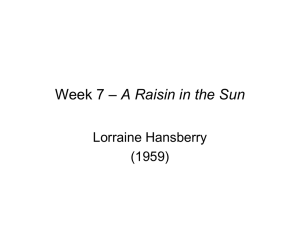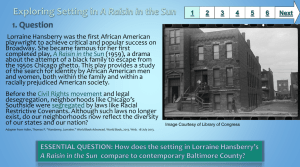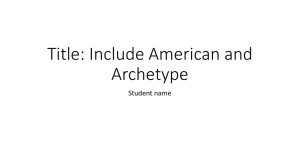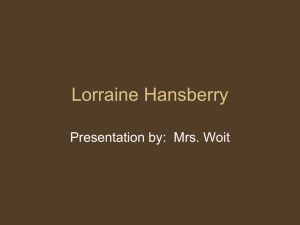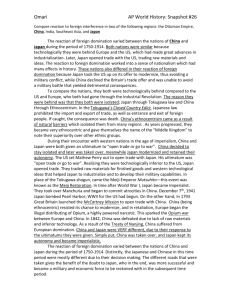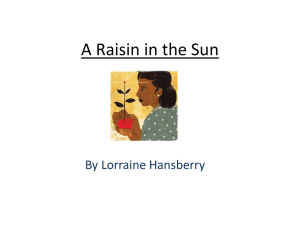(t)raw model - Cloudfront.net
advertisement
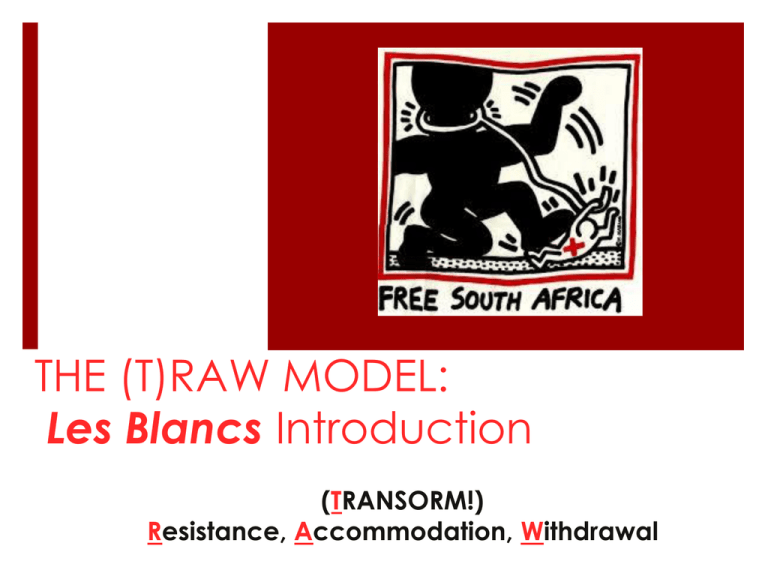
THE (T)RAW MODEL: Les Blancs Introduction (TRANSORM!) Resistance, Accommodation, Withdrawal Agenda: 1. RAP 2. Elbow Partner Sharing. 3. Corner Activity and Discussion of (T)RAW 4. (T)RAW Power Point) 5. Intro Mindwrites 6. Read Lorraine Hansberry Bio 7. Intro Active Reading: Actively read bio 8. Intro Les Blancs by Lorraine Hansberry, Waves of Imperialism, Colonial Mindset, “White Man’s Burden” (If time) Common Core Standards: Covering Today… Participate effectively in a range of conversations and collaborations with diverse partners, building on others’ ideas and expressing their own clearly and persuasively. Integrate and evaluate information presented in diverse media and formats, including visually, quantitatively, and orally. Cite strong and thorough textual evidence to support analysis of what the text says explicitly as well as inferences drawn from the text Analyze a particular point of view or cultural experience reflected in a work of literature from outside/inside the United States, drawing on a wide reading of world literature Engage and orient the reader by setting out a problem, situation, or observation, establishing one or multiple point(s) of view, and introducing a narrator and/or characters; create a smooth progression of experiences or events Initiate and participate effectively in a range of collaborative discussions (one-on-one, in groups, and teacher-led) with diverse partners on grades 9-10 topics, texts, and issues, building on others' ideas and expressing their own clearly and persuasively Determine the central ideas or information of a primary or secondary source; provide an accurate summary of how key events or ideas develop over the course of the text. R.A.P. Journal Question Review and Preview (rap) Here is a dilemma. Someone is trying to hurt, dominate or oppress you due to either your race, class, gender, sexual identity, religion and/or age (or they are just trying to bully you). What do you do? Do you (1) resist and fight back passively/actively, (2) accommodate them and just go along, (3) withdrawal or get out of the situation either physically or mentally, or (4) try to change or transform them, the situation, others and/or yourself? Why do you do what you do and react that way? How does it make you feel to respond that way? DOMINATION/SUBORDINATION? Domination: the exercise of control or influence over someone or something, or the state of being so controlled Subordination: inferiority, subjection, subservience Autonomy Autonomy: freedom from external control or influence; independence What we all face… We want to define and control our own lives and we all want others to likewise have that freedom of autonomy; free from domination! Self determination! I determine who I am and want to be! THE POWER CONTINUUM On the line of power we go from total domination (Powerless Victim/Slave) to total freedom (SelfDetermination/Powerful/Agent). We are hardly ever totally one way or the other. We constantly move on this line. DOMINATION------<-----------SUBORDINATION POWERLESS-------<---------SELF DETERMINED THE BIG QUESTION…? So what happens when one group/person directly or indirectly subverts, or power-overs, the independence of another group/person? …They RESIST, ACCOMMODATE, WITHDRAWAL and/or TRANSFORM How does this work? As groups move on the common continuum due to the first proximity and then deeper levels of interaction, the less powerful group, fearing domination, attempts to preserve their unity and integrity by defending their society and lifestyle… The goal is to maintain their “cultural life” or autonomy and thus thwart/undermine the attempts of domination or total control over them… Resistance! Resistance: the refusal to accept or comply with something; the attempt to prevent something by action or argument Active Resistance: open warfare Passive Resistance: poisoning food while acting friendly Accommodation Full Assimilation: learn the rules of the dominator Bi-cultural Assimilation: be part of the rules of the dominate while practicing your own beliefs in private Pluralism: practicing autonomy in dominate culture Withdrawal… Physical: you leave or removed from situation Emotional/Psychological: “drop out” or drugs/alcohol TRANSFORM! make a thorough or dramatic change in the form, appearance, or character of a people, culture or nation (very rare person) We will focus on Lorraine Hansberry as someone that transforms and writes about (T)RAW. We will read her play, Les Blancs and study the waves of imperialism, the colonial mindset, and read “The White Man’s Burden” using the strategies and tools of composition, character analysis or Mindwrites while Actively Reading. ACTIVE READING: Hansberry Use a Blue Pen or Underline: To identify and clarify main ideas - Single out key phrases that seem to be the main ideas the author wants to get across. - Summarize these main ideas in the margin, using your own words. Use a Red Pen or Circle: To identify and clarify key vocabulary terms and all unfamiliar terms - Single out key vocabulary terms - Single out at least two unfamiliar vocabulary terms (there is always unfamiliar vocabulary). - Define all the terms in the margin. Use a Black Pen or an Asterisk (*): To connect, evaluate, and synthesize main ideas - Briefly note connections you have made in the margin. - Briefly note questions, examples, counter-examples, counter-arguments or new ideas in the margin. MINDWRITE: Hansberry Who are they? What is their rank; if any? Who do they associate with (other characters)? Where do they live? Thoughts- What do they think about? Actions- What do they do? Personality Traits- How do they act? What is their attitude towards things, events, people etc? Physical Traits- What do they look like? (if no picture, then use your imagination) Motivations- Why do they do what they do? Impact- How have they created change and/or influenced others? What is their legacy? POV- What would the other characters say about the character? Quotes- Important & relevant things the character said. Thematic- How do these characters demonstrate the themes Thank you! The End… Or is it just the beginning?
